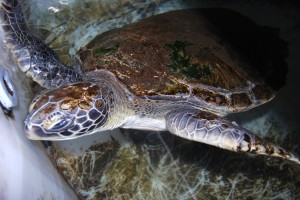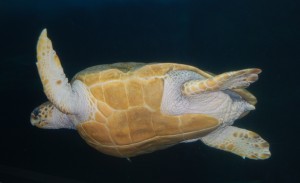 I < had never seen a sea turtle up close before as they swim in warm, temperate waters like the Indian Ocean off the eastern seaboard of South Africa and I live in the Western Cape with its cold, stormy Atlantic Ocean. Sea turtles are also not a showy marine species like the mighty whales that visit our area, so my experience of them was nil and my understanding limited at best.
However, when I met gentle Bob, a green turtle being rehabilitated at the Two Oceans Aquarium at the V&A Waterfront in Cape Town, I felt an instant empathy for him and others of his species. His plight touched me deeply as his story seemed symbolic of so much of the world's marine and terrestrial life.
Bob was found washed up on a Cape beach, cold, weak and dehydrated. He had been badly hurt on his bottom shell. He seemed to be blind. And he had ingested a quantity of deflated balloons and other bits of plastic. In fact Bob was on the point of being euthanased.
He has required months of intensive care from the Two Oceans' dedicated team of aquarists and veterinary surgeon in the form of tube feeding, antibiotics, daily wound care and fluid intake and his recovery has been an up and down process. But he has now gained weight and has been moved into a pool permanently. Things are looking up for Bob and the day I met him he seemed to have almost fully recovered.
I < had never seen a sea turtle up close before as they swim in warm, temperate waters like the Indian Ocean off the eastern seaboard of South Africa and I live in the Western Cape with its cold, stormy Atlantic Ocean. Sea turtles are also not a showy marine species like the mighty whales that visit our area, so my experience of them was nil and my understanding limited at best.
However, when I met gentle Bob, a green turtle being rehabilitated at the Two Oceans Aquarium at the V&A Waterfront in Cape Town, I felt an instant empathy for him and others of his species. His plight touched me deeply as his story seemed symbolic of so much of the world's marine and terrestrial life.
Bob was found washed up on a Cape beach, cold, weak and dehydrated. He had been badly hurt on his bottom shell. He seemed to be blind. And he had ingested a quantity of deflated balloons and other bits of plastic. In fact Bob was on the point of being euthanased.
He has required months of intensive care from the Two Oceans' dedicated team of aquarists and veterinary surgeon in the form of tube feeding, antibiotics, daily wound care and fluid intake and his recovery has been an up and down process. But he has now gained weight and has been moved into a pool permanently. Things are looking up for Bob and the day I met him he seemed to have almost fully recovered.
 As living dinosaurs, sea turtles have been swimming in the planet’s ocean for some 100 million years, having survived at least one mass extinction. Now, however, all seven sea turtle species are threatened with extinction. How unbelievably wonderful it would be if through a massive worldwide conservation effort we could once again have turtles swimming freely and numerously in the global ocean?
As living dinosaurs, sea turtles have been swimming in the planet’s ocean for some 100 million years, having survived at least one mass extinction. Now, however, all seven sea turtle species are threatened with extinction. How unbelievably wonderful it would be if through a massive worldwide conservation effort we could once again have turtles swimming freely and numerously in the global ocean?